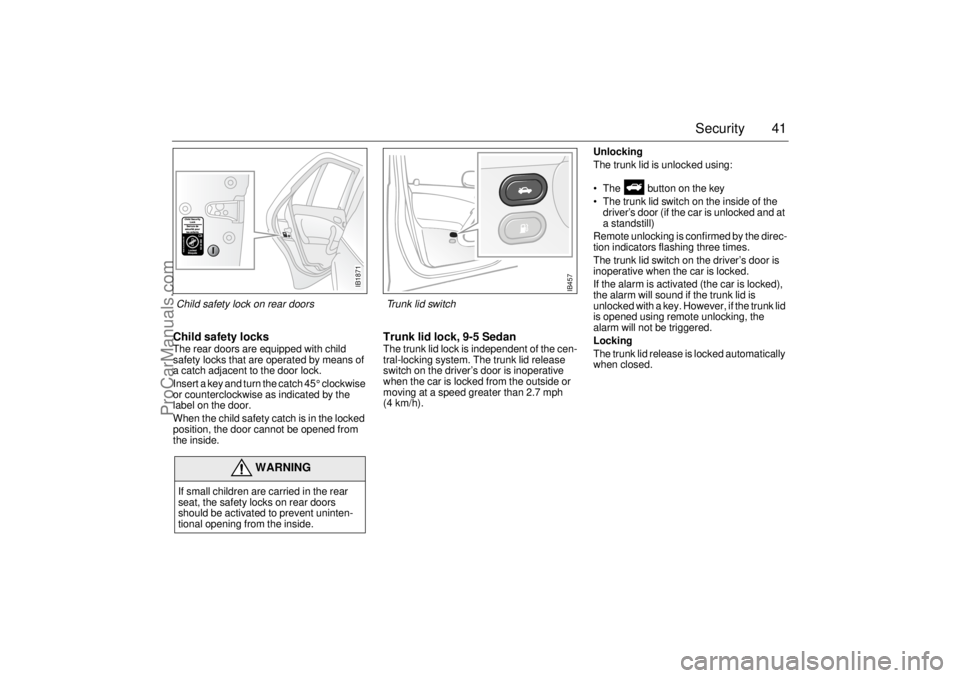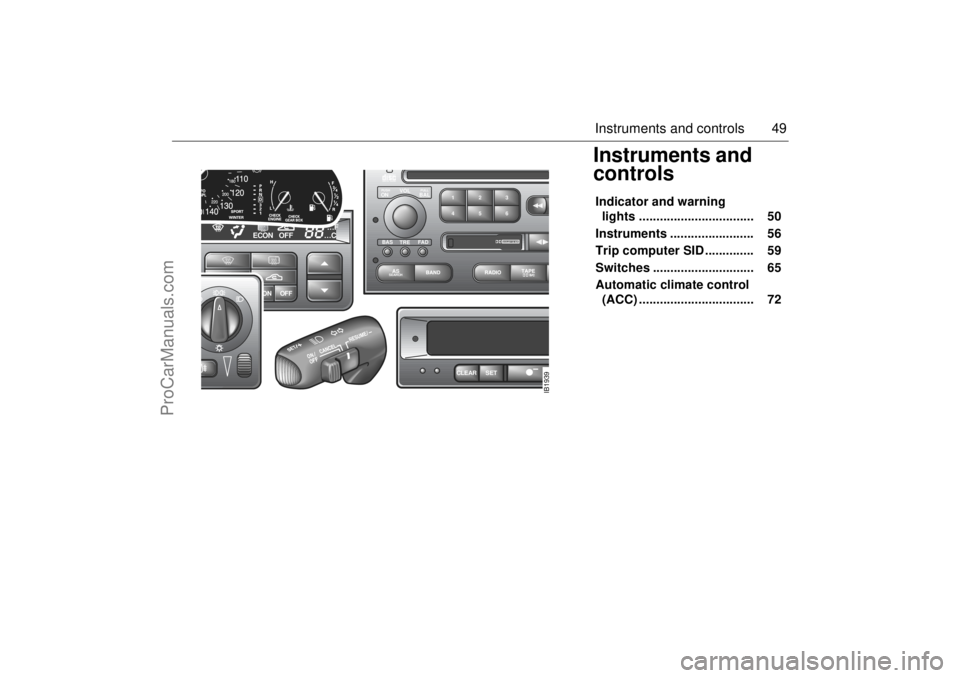SAAB 9-5 2002 Service Manual
Manufacturer: SAAB, Model Year: 2002, Model line: 9-5, Model: SAAB 9-5 2002Pages: 272, PDF Size: 16.26 MB
Page 41 of 272

41 Security
Child safety locksThe rear doors are equipped with child
safety locks that are operated by means of
a catch adjacent to the door lock.
Insert a key and turn the catch 45° clockwise
or counterclockwise as indicated by the
label on the door.
When the child safety catch is in the locked
position, the door cannot be opened from
the inside.
Trunk lid lock, 9-5 SedanThe trunk lid lock is independent of the cen-
tral-locking system. The trunk lid release
switch on the driver’s door is inoperative
when the car is locked from the outside or
moving at a speed greater than 2.7 mph
(4 km/h).Unlocking
The trunk lid is unlocked using:
The button on the key
The trunk lid switch on the inside of the
driver’s door (if the car is unlocked and at
a standstill)
Remote unlocking is confirmed by the direc-
tion indicators flashing three times.
The trunk lid switch on the driver’s door is
inoperative when the car is locked.
If the alarm is activated (the car is locked),
the alarm will sound if the trunk lid is
unlocked with a key. However, if the trunk lid
is opened using remote unlocking, the
alarm will not be triggered.
Locking
The trunk lid release is locked automatically
when closed.
WARNING
If small children are carried in the rear
seat, the safety locks on rear doors
should be activated to prevent uninten-
tional opening from the inside.
IB1871
Child safety lock on rear doors
IB457
Trunk lid switch
ProCarManuals.com
Page 42 of 272

42 SecurityTrunk Release HandleThere is a glow-in-the-dark trunk release
handle located inside the trunk on the latch.
This handle will glow following exposure to
light. Pull the release handle down to open
the trunk from the inside.
Tailgate, 9-5 WagonThe tailgate is not unlocked when the other
car doors are unlocked. The tailgate button
on the driver’s door is inoperative when the
car is locked or moving at a speed greater
than 4 km/h.
Unlocking
The tailgate is unlocked using:
The button on the key
The tailgate switch on the inside of the
driver’s door (if the car is unlocked and at
a standstill) or
Manually, using the key in the trunk lock.
Remote unlocking is confirmed by the direc-
tion indicators flashing three times.
If the alarm is activated (the car is locked),
the alarm will sound if the tailgate is
unlocked with a key. However, if the tail-
gate is opened using remote unlocking, the
alarm will not be triggered.
Locking
The tailgate is locked using:
The button on the key
The button on the centre console
The key in the driver’s door.
NOTEThe trunk release handle was not
designed to be used to tie down the trunk
lid or as a an anchor point when securing
items in the trunk. Improper use of the
trunk release could damage it.
IB1879
Use the key to prise out the cover plate
covering the lock, 9-5 Wagon
IB1880
Unlocking the tailgate with a key,
9-5 Wagon
IB1833
Trunk Release Handle
ProCarManuals.com
Page 43 of 272

43 Security
Car alarm The car alarm (anti-theft system) is acti-
vated/deactivated when the car is
locked/unlocked by the remote control or by
the key, see page 39.
The antenna for the alarm system is located
in the center console.
All the doors plus trunk lid/tailgate and hood
are monitored by microswitches, and win-
dow-glass sensors will trigger the alarm if
any glass is broken. Your Saab 9-5 is equipped with an Elec-
tronic starting interlock (immobilizer), see
page 44 for details.
The car alarm is armed 10 seconds after the
car has been locked by the remote control.
During this ten-second delay period, the
doors, trunk lid/tailgate and hood may still
be opened without the alarm being trig-
gered.
The LED indicator on the instrument panel
fascia will be on continuously during this
period, at the end of which it will start to flash
(once every other second). If a door or the trunk lid/tailgate or hood has
been left open when the car is locked, the
LED on the fascia will flash (three times per
second) for ten seconds to indicate this.
Check to ensure that all the doors, plus
trunk lid/tailgate and hood, are closed prop-
erly.
If the fault persists (LED flashing when
renewed attempt made to activate the car
alarm by remote control), lock the car using
the key instead. The car alarm will not have
been activated and you should get in touch
with an authorized Saab dealer.
To avert inconvenience caused by the
alarm being triggered inadvertently, make
sure that anyone else using the car is famil-
iar with how both the car alarm and the lock-
ing system work.
If the alarm is tripped (the direction indica-
tors are flashing and the siren is on) it can
be turned off by unlocking the car using the
button.
WARNING
Leaving children or pets unattended in a
locked car is dangerous. It is also danger-
ous to leave children in a vehicle with the
ignition key. A child or others could be
badly injured or even killed.
IB1524
3
2 1
Remote control 1 Activate/lock
2 Deactivate/unlock
3 Unlock trunk/tailgate
Unlocking the tailgate (9-5 Wagon)
ProCarManuals.com
Page 44 of 272

44 SecurityActivating the car alarm The car alarm cannot be activated if the
driver’s door is open or if the ignition switch
is in ON position.
If, on the other hand, one of the other doors
or the trunk or hood is open or opened and
not closed again during the 10-seconds
delay period, it will be excluded from the
alarm function.
If it is then closed, a new delay period of ten
seconds will start, and the door (or trunk or
hood) will once again be secured by the
alarm system.
As usual, the LED will be on continuously
during the new delay period and will start to
flash once every other second after the
10-seconds period has elapsed.
Window glass sensorThe car-alarm system incorporates a
sensor that monitors the window glass for
the sound of breakage. The sensor is fitted
inside the rear dome light.
To avoid false alarms, such as the alarm
being triggered by noise from passers by
when the windows have been left open, or
when children or pets are left inside the car,
the sensor can be temporarily disabled.
To disable the sensor
To disable the sensor, first turn off the igni-
tion and remove the key from the switch.
Next, press and hold the NIGHT PANEL
button until ”DOOR ALARM ONLY” appears
on the SID and a chime sounds. The car
alarm must now be activated within three
minutes, or the glass sensor will become
active again.
The glass sensor will be enabled again
automatically when the car is next unlocked.
The sensor can also be enabled again by
repeating the procedure for disabling it.
When the sensor has been enabled, ”FULL
THEFT ALARM” will appear on the SID.
If a fault is detected in the glass sensor,
”SERVICE THEFT ALARM” will appear on
the SID.
Electronic starting interlock
(immobilizer) When the key is inserted in the ignition, a
signal is sent to the receiver. If the signal is
verified, the engine can be started.
Each time the key is removed from the igni-
tion, the electronic immobilizer is activated.
This means that the car cannot be started
without the correct key inserted in the igni-
tion and the immobilizer thus deactivated.
If a fault is detected (e.g. in the transmitter)
”KEY NOT ACCEPTED” will appear on the
SID.
In this case, you can still start the car if you
turn the ignition key to ON and press one of
the buttons on the key (providing that the
receiver gets the right signal from the key).
Take the car to an authorized Saab dealer
to have the system checked.
The LED double-flashes when the car is
immobilized.
ProCarManuals.com
Page 45 of 272

45 Security
Alarm signals When the car alarm is armed, it will be trig-
gered if any door, or the trunk lid or hood, is
opened or if a window is broken.
The alarm will also be triggered if an attempt
is made to bypass or short-circuit the igni-
tion switch, or to disconnect the battery.
If the alarm is triggered, the following alarm
signals will be set off:
Flashing of hazard warning lights for five
minutes.
Siren wailing for 30 seconds.
The alarm signals will stop if the alarm is
deactivated (car unlocked) during the alarm
period.
The alarm siren has a long-life battery
(approx. 10 years), see ”SERVICE THEFT
ALARM”, on page 47. When the battery
goes dead, the siren must be replaced: it is
not possible to change the batteries.
Panic-functionIn the car alarm system is a function called
"Panic-function".
To activate panic function:
Push and hold one of the buttons on the
key for 2 seconds. Or, if you are sitting
inside the car, push the LOCK-switch on
the center console for 2 seconds.
These actions will trigger the alarm (hazard
warning lights and siren).
To deactivate panic function:
Push one of the buttons on the key, push
the LOCK-switch in the center console,
turn the key in the driver´s door or turn the
ignition to ON.
When the panic-function is activated the car
will be locked/unlocked depending upon
which button was pushed.
When the ignition is ON the panic-function
cannot be activated.
NOTE It is possible to inadvertently deacti-
vate the car alarm and at the same
time unlock the car, if the button on the
key is pressed by mistake when the
car is still within its range.
When locking the car by remote con-
trol in extremely cold weather, it is
advisable to check that the lock
system has operated properly. To do
so, check that the interior locking but-
tons are all down.
If not, unlock and relock the car again.
ProCarManuals.com
Page 46 of 272

46 SecurityOverview of functions
Alarm signals may differ between model variants for different coun-
tries.
Some of the car-alarm functions can be reprogrammed – con-
sult your Saab dealer for further details (see page 259). Locking/
activation Hazard warning lights flash once and the horn
chirps once.
The LED will come on for 10 seconds.
Unlocking/
deactivation Hazard warning lights flash twice and the horn
chirps twice.
The LED will come on for two seconds.
Unlocking/
deactivation of
trunk lid/tailgate
alarm Hazard warning lights flash three times and the
horn chirps three times.
The LED will flash three times per second for 10
seconds.
Alarm triggered Hazard warning lights flash for 5 min.
Siren wails for 30 seconds.
To switch off the alarm, deactivate the system in
the normal way (unlocking).
Window-glass
sensor The sensor detects if any window is broken and
triggers the alarm.
To disable the sensor, see page 44.
Key The range of the key is normally 5-10 yds.
(5-10 metres), although it can be substantially
more than this in ideal conditions.
If the key is not working, it may be because the
code signal has not been synchronized with that
in the control module for the car alarm. To rectify
this, press the unlock button on the key at least
four times in quick succession. When it is recog-
nized, the door locks will cycle.
If a key is lost, the new one will have to be pro-
grammed (all keys must be present) to match the
car’s unique security code. Contact an author-
ized Saab dealer.Battery for key The battery for the key will normally have a life of
4 years. When the battery needs changing,
”REPLACE KEY BATTERY” will appear on the
SID.
Contact an authorized Saab dealer.
Car-battery
voltage If the battery is disconnected while the alarm is
active (car is locked), for example during an
attempt to steal the car, the alarm will be trig-
gered.
ProCarManuals.com
Page 47 of 272

47 Security
Overview of LED signals and SID messagesSome signals may differ between model variants for different
countries.Status LED signal
Activation (during 10-second delay). Comes on for 10 seconds.
Alarm activated (after delay). Flashes once every other
second.
Deactivation. Comes on for 2 seconds.
Alarm not activated. Off.
Door, trunk lid/tailgate or hood open
or opened during delay period.Flashes three times per sec-
ond for 10 seconds.
Unlocking the trunk lid/tailgate. Flashes three times per sec-
ond for 10 seconds.
Closing of door, trunk lid/tailgate or
hood after delay period.Comes on for 10 seconds.
Car immobilized but not locked.
Car alarm not activated.Flashes twice at three sec-
onds intervals.
Fault in a switch serving doors, hood
or trunk lid.Flashing (instead of being
on continuously) during
delay period.
SID message Reason/action
SERVICE THEFT ALARM Probably a fault in one of the sensors
or the alarm siren.
Have the car checked by an autho-
rized Saab dealer.
KEY NOT ACCEPTED Fault in key transmitter or in igni-
tion-switch receiver.
Turn ignition switch to ON and press
the unlock button on the key. Start
the engine.
Have the car checked by an autho-
rized Saab dealer.
REPLACE KEY BATTERY Fit a new battery in the key, see page
40.
DOOR ALARM ONLY Window-glass sensor disabled.
FULL THEFT ALARM Window-glass sensor in circuit.
REMOTE KEY
TRANSPONDRTurn the ignition key to position ON
and then press the button for open-
ing the trunk lid. SID displays the
number of keys and transmitters
(transponders) coded to the car.
ProCarManuals.com
Page 48 of 272

48 SecurityCanada only:This device complies with Part 15 of the FCC Rules. Operation is
subject to the following two conditions: (1) this device may not
cause harmful interference, and (2) must accept any interference
received, including interference that may cause undesired oper-
ation.
Changes or modifications not expressly approved by the manu-
facturer could void the user´s authority to operate the equipment.
This device complies with RSS-210 of Industry Canada. Opera-
tion is subject to the following two conditions: (1) this device may
not cause interference, and (2) this device must accept any inter-
ference, including interference that may cause undesired opera-
tion of the device.
ProCarManuals.com
Page 49 of 272

49 Instruments and controls
Instruments and
controls Indicator and warning
lights ................................. 50
Instruments ........................ 56
Trip computer SID .............. 59
Switches ............................. 65
Automatic climate control
(ACC) ................................. 72
ECON OFF
…F
…C
ECON OFF
CLEAR
SET
IB1939
VOL
TREBAL ON
FA D BAS
PULL PUSH
ASSEARCH
2 13
5 46
DOLBY B NR
ProCarManuals.com
Page 50 of 272

50 Instruments and controls
Indicator and warning
lights A number of indicator and warning lights will
come on when the ignition is switched on
prior to starting. Under normal conditions,
these should go out a few seconds after the
engine has started (see page 56).
Warning, oil pressure
(engine oil)
This light will come on together with if
the engine oil pressure is dangerously low.
If the light flashes or comes on while you are
driving, stop the car, switch off the engine
and check the engine oil level (see page
193). NOTEUnder no circumstances must the car be
driven when the warning light is on. Low
oil pressure can result in serious engine
damage.
Main instrument panel 1 Tachometer
2 Indicator and warning lights
3 Speedometer
4 Indicator and warning lights
5 Pressure gauge6 Fuel gauge
7 Engine temperature gauge
8 Trip meter reset button
9 Odometer and trip meter
2030405060
70
80
90
100
11 0
120
130
140
150
160
240
260220200180160
140 120 100
80
60
40
20
10
7
IB1810
9
4
5
3
2
8
6
1
ProCarManuals.com